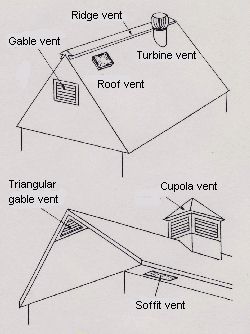| Ridge vents. Cupola vents. Roof vents. Soffit vents. Turbine Vents. Powered attic vents |
|
Turbine vents are wind powered. They may need maintenance (lubrication) and can become noisy or get stuck. They are not very effective when there is no wind. On very windy days they may draw more air than is available in the attic space which creates negative pressure. This negative pressure in turn draws warm air from the living area below.
Powered vents can create negative pressure in the attic (like the turbine vent) and some sources do not recommend using a power vent during the winter (when good ventilation is a must) because of the possible heat loss. Motors and humidity sensors are prone to failure. |
|
|
.
.
..
.
|
| Roof and Soffit Vents |
|
| . |
Need more information? Use our search box
Ridge vents. Cupola vents. Roof vents. Soffit vents. Turbine Vents. Powered attic vents
Vents should be uniformly spaced to provide good cross ventilation from end to end and from top to bottom. Vents come in many shapes, sizes and colours and are made from aluminum or vinyl.
50% Of the ventilation should be located in the soffits, or eaves, and 50% near the ridge or peak.
The first five vents discussed below are fixed non-powered devices and take advantage of the natural flow of air. Cool air enters the lower vents, is warmed, then rises and exits through the upper vents to expel both heat and humid air.
This group of vents is economical, effective, have no moving parts that can seize, are relatively easy to install and last a lifetime.
Roof vents are installed near the ridge and are the most common vents for this location.
Soffit vents should be installed close to the fascia board. The vents can be either the continuous type which run the length of the soffit or the rectangular shaped vents which should be evenly spaced.
The continuous strip vents provide more ventilation, but are more expensive to install. Soffit vents should be kept open and free of insulation by installing baffles in the attic.
Ridge vents run as the name already suggest along the ridge. Metal ridge vents are available in a choice of factory finished colours.
Some types can be covered with a regular ridge cap. There is also a polyester fibre ridge vent available. It is sold in 32 ft. (9.6 m) long rolls and is only 5/8" thick (16 mm). It is covered with a regular asphalt ridge cap.
Gable vents should be installed as high as possible. The vents are square, rectangular or triangular. There is also an adjustable or louvered vent available.
Cupola vents have been around 'for ages' but are seldom used on homes in the suburbs. they are usually made of wood and are often custom built to compliment or enhance the house's appearance. |
 |
|
|
|
|
Back to Top |
|
|
|